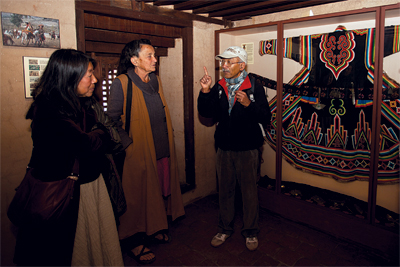The group stopped again in front of a tall inscribed pillar, and the two scholars in the group began discussing its history, significance, beauty and uniqueness. The inscription carved into the surface of this column is the oldest in the Kathmandu Valley, dating from 464 A.D. Conjectures were even made about what might lie beneath the pillar’s base, now standing in front of the Vishnu Narayan temple in the main courtyard. They started walking again and all of us in the group followed. Then they would stop to admire another stone sculpture, then another. Someone had to interrupt the scholars and remind them that all of us needed to start the meeting that had brought us all there in the first place.
 The two scholars were Mukunda Raj Aryal, a retired professor and scholar of Nepali culture, who has researched on Changu Narayan for over 30 years and Sukra Sagar Shrestha, one of Nepal’s eminent archaeologists. Listening to them in rapt admiration were art conservator Naoko Takagi ,art consultant James Giambrone, photographer and founder-director of Indigo Gallery in Naxal, Mukti Singh Thapa, a traditional pauwa painter, and Suresh Shrestha, supervisor of a recent restoration of a northern segment of the Chaugara Sattal, the chambers surrounding the complex of temples. Smiling at this coming together of Nepalis and foreigners – at the lengthy expositions of the two experts – was Judith Conant Chase, founder-director of the Living Traditions Museum located within the temple premises. Photographs and objects she had collected during many years of travels in Nepal filled the section that was already open to the public. She had invited this group, an informal advisory committee of sorts, to ask for suggestions on a new section of the museum.
The two scholars were Mukunda Raj Aryal, a retired professor and scholar of Nepali culture, who has researched on Changu Narayan for over 30 years and Sukra Sagar Shrestha, one of Nepal’s eminent archaeologists. Listening to them in rapt admiration were art conservator Naoko Takagi ,art consultant James Giambrone, photographer and founder-director of Indigo Gallery in Naxal, Mukti Singh Thapa, a traditional pauwa painter, and Suresh Shrestha, supervisor of a recent restoration of a northern segment of the Chaugara Sattal, the chambers surrounding the complex of temples. Smiling at this coming together of Nepalis and foreigners – at the lengthy expositions of the two experts – was Judith Conant Chase, founder-director of the Living Traditions Museum located within the temple premises. Photographs and objects she had collected during many years of travels in Nepal filled the section that was already open to the public. She had invited this group, an informal advisory committee of sorts, to ask for suggestions on a new section of the museum.
 We climbed a wooden stairwell to the gallery that fills the recently restored section. Judith explained, while also asking for suggestions, what she planned to install in this gallery. The exhibition would include a painting or series of paintings depicting popular legends related to Changu Narayan, historic photos of Changu Narayan and its surroundings and a selection of the carved wooden struts and stone sculptures now stored in a dark and dusty corner of a temple porch.
We climbed a wooden stairwell to the gallery that fills the recently restored section. Judith explained, while also asking for suggestions, what she planned to install in this gallery. The exhibition would include a painting or series of paintings depicting popular legends related to Changu Narayan, historic photos of Changu Narayan and its surroundings and a selection of the carved wooden struts and stone sculptures now stored in a dark and dusty corner of a temple porch.
Judith also wants to reconstruct, in a photograph, the great stone pillar that once stood in front of the Vishnu Narayan temple. Broken into five segments during an earthquake, it now stands in disconnected pieces. Her idea is to invite photographers to take photos of the sections and reconstruct the pillar photographically into its original form, with the iconic stone Garuda at the apex. For this she will be holding a photography competition in February 2013. The winner will have her or his photo of the pillar printed on a silk cloth to be hung against the 20 foot high wall of the entrance to the gallery.










